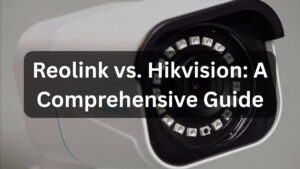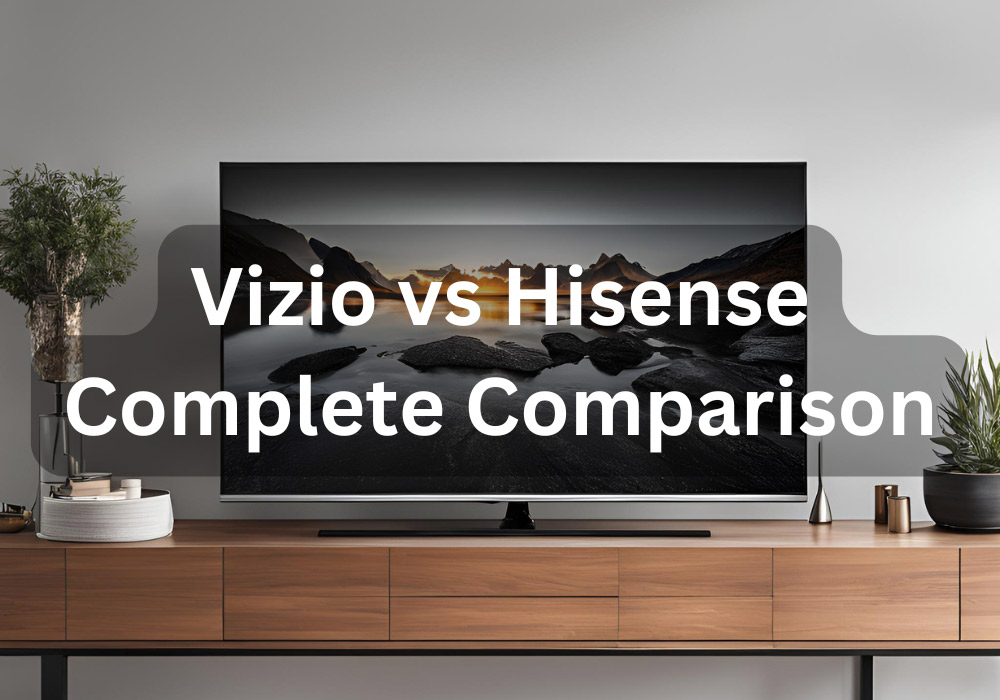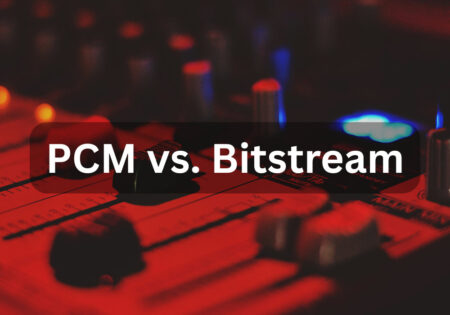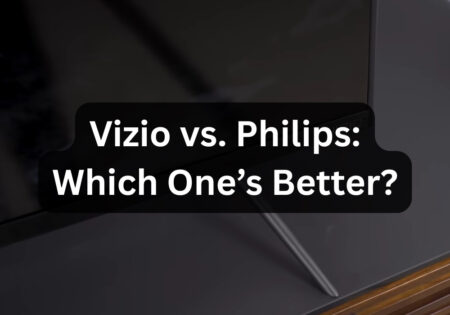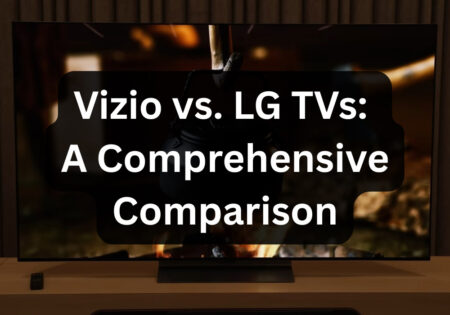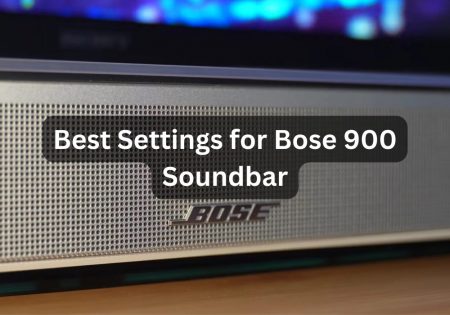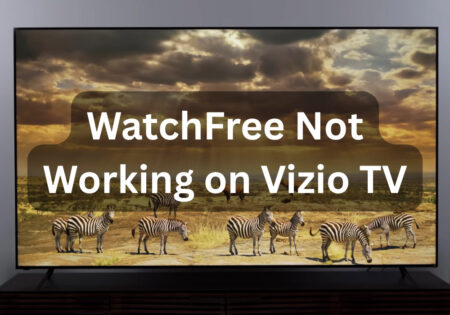Comparing Vizio vs Hisense can be a bit tricky, as they both offer competitive TVs in each price range. In this article, I’ll compare these brands in terms of picture quality, smart features, gaming performance, build quality, sound, connectivity, and overall value. Whether you’re looking for a budget or premium TV from Vizio or Hisense, this guide is for you.
Vizio vs Hisense: Which is Better? (Quick Answer)
According to our tests, Hisense TVs are better than Vizio TVs in general, since they provide better picture quality, gaming experience, and connectivity options.
Hisense TVs, particularly U6K, U7K, and U8K series are superior in terms of brightness, contrast, and advanced features across all price ranges. However, for those who are on a budget less than $500, the Vizio V-Series offers solid options, particularly with their SmartCast platform and decent gaming features.
| Category | Vizio | Hisense | Winner |
|---|---|---|---|
| Picture Quality | Good color accuracy, but lower brightness and contrast; limited viewing angles. | Better brightness, contrast, and color vibrancy with ULED and Mini-LED tech. Limited viewing angles. | Hisense |
| Smart Features | SmartCast is simple but slow on budget models; supports AirPlay and Google Cast. | Google TV and Roku are faster and more polished; VIDAA OS is intuitive. | Hisense |
| Gaming Performance | Decent gaming features (VRR, low lag, HDMI 2.1), but slightly less immersive. | Similar features, but better brightness and contrast enhance gaming experience. | Hisense |
| Connectivity | Fewer HDMI 2.1 ports; eARC included. | More HDMI 2.1 ports; eARC included. | Hisense |
| Build Quality | Modern design with slim bezels; mix of metal and plastic. | Durable, industrial design, with functional materials. | Hisense |
| Sound Quality | High-quality soundbars and subwoofers for enhanced sound. | Decent TV speakers but no dedicated soundbars. | Vizio |
Brands Overview
When trying to find the best smart TVs that suit your needs, it is important to get familiar with brands as a whole. So, let’s get to know Vizio and Hisense to understand how they compare to each other.

Vizio: Affordable Innovation at Every Home
Vizio is an American brand that’s well-known for manufacturing soundbars, subwoofers, and TVs that come with innovative technology (like Quantum Dot) and a friendly price tag at the same time. They had a brief lull but managed to make a strong comeback and refine their products to deliver the quality they’re famous for.
A standout feature of Vizio TVs is their SmartCast platform, which makes streaming super easy. Additionally, Vizio supports AirPlay and Google Cast, so whether you’re an Apple or Google fan, you won’t be disappointed. If you’re a big fan of Vizio TVs, I suggest you read my guide on the best Vizio smart TVs.
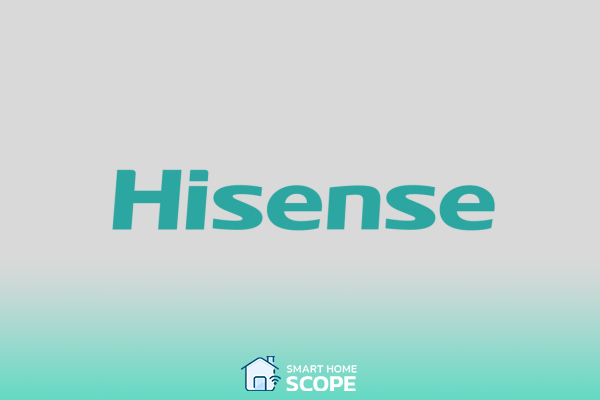
Hisense: Cutting-Edge Technology at an Affordable Price
Hisense is a brand originally from China and has been around longer than Vizio (since 1969). Hisense has successfully become a famous brand and rapidly climbed the ranks, especially in the last few years.
Hisense TVs are built with advanced technologies like ULED and Mini-LED. What does this mean for you? It means you’ll get picture quality with stunning brightness, contrast, and color, at a very affordable price!
Hisense’s philosophy is clear to me: give people more for less, and they’ll keep coming back!
Although the main smart platform that Hisense TVs usually come with is Google TV (Android TV), they also offer TVs with the Roku platform or their VIDAA OS. Either way, Hisense offers a smooth user experience with cutting-edge features, making it a great brand to consider at every price range.
Also Read:
Vizio vs. Samsung
Vizio vs Hisense: Picture Quality
If we’re trying to compare Vizio with Hisense in terms of picture quality, it’s very important to do this in separate price categories: budget, midrange, and premium. In each price range, I’ll introduce one of the best models from each brand and compare them to see which is better when it comes to picture quality.
Vizio V-Series vs Hisense U6K (Budget Picture Quality)
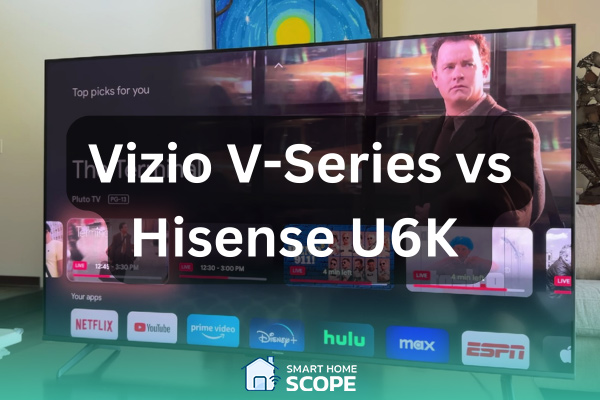
Both Hisense and Vizio offer decent quality when it comes to low-priced TVs, but there are some key differences.
Vizio’s budget models, like those in the Vizio V-Series, offer great color accuracy but fall short in terms of brightness and contrast. They come with VA panels, which are great for contrast and black levels, but can suffer from narrow viewing angles.
Hisense, on the other hand, slightly edges out Vizio with models like the Hisense U6K. Thanks to the ULED technology, colors are much more vibrant, and contrast is improved. However, Hisense’s budget TVs use VA panels similar to Vizio’s, so the viewing angles are not ideal.
Vizio M-Series Quantum vs Hisense U7K (Midrange Picture Quality)
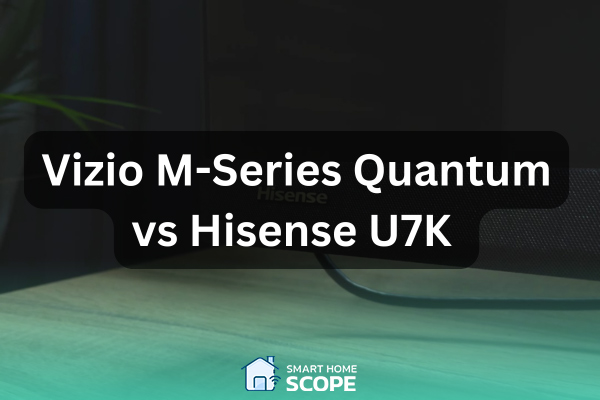
The Vizio vs Hisense competition heats up as we step into the midrange zone.
Vizio M-Series Quantum TVs show their strength with their Quantum Dot Technology, which enhances color accuracy and vibrancy in a way that I find very interesting. Brightness is much better than Vizio’s budget TVs, and HDR content looks way more dynamic. Although the picture quality is much better than the budget Vizio series, the M-Series still uses VA panels, which means the viewing angles are still not good.
Since Hisense offers models such as the Hisense U7K in this price range, it’s still the superior brand compared to Vizio. Hisense midrange TVs continue to push forward due to combining ULED technology with Mini-LED backlighting, making them exceptional in terms of brightness and contrast, in a way that can even rival premium models from other brands!
Hisense also tends to handle black levels better in this range, thanks to more advanced local dimming features. They still utilize VA panels, which is a bummer, but the overall picture quality is pitch perfect for a midrange TV, especially when it comes to brightness and color saturation.
Also Read:
Insignia vs Hisense
Vizio P-Series Quantum X vs Hisense U8K (Premium Picture Quality)
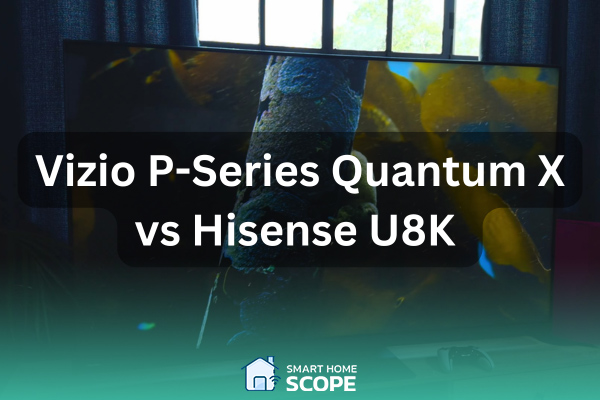
Both brands continue to make the competition even hotter at this price range.
Vizio offers the P-Series Quantum X. These TVs offer impressive brightness, deep blacks, and exceptional color accuracy thanks to their advanced Quantum Dot and full-array local dimming technology. These TVs are amazing when it comes to HDR content; the experience is exactly the cinema-like vibe you’d expect from a premium TV. However, the viewing angles are still frustrating.
Even at this price point, Vizio TVs come with VA panels that will make the colors look washed out when not sitting directly in front of the TV.
Hisense’s premium offerings, like the U8K series, use a combination of Mini-LED and ULED technologies that make them rich in brightness, contrast, color vibrancy, and black levels. Similar to the other budget classes, Hisense premium models outperform Vizio’s when it comes to picture quality. Additionally, Hisense performs better in handling HDR content, helping viewers get the most out of their 4K content.
Like Vizio, Hisense loves to equip its TVs with VA panels—even in premium TVs like the U8K. So, expect to have limited viewing angles.
In the Vizio vs Hisense battle, the U8K series from Hisense seamlessly blends Mini-LED and ULED, achieving unmatched brightness and color depth, consistently eclipsing Vizio in picture quality.
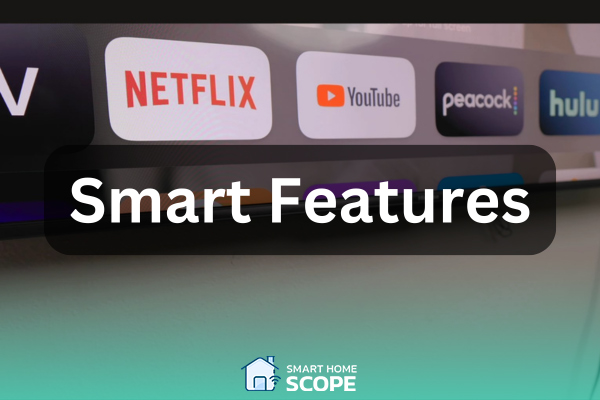
Hisense vs Vizio: Smart Features and User Experience
Vizio TVs Smart Features and User Experience
Vizio’s main smart platform is SmartCast. SmartCast was a bit sluggish and difficult to navigate in the early years. However, Vizio has managed to improve the user experience with recent updates.
SmartCast now includes the most popular streaming apps like Netflix, Hulu, and Disney+. Additionally, SmartCast offers integration with both Apple AirPlay and Google Cast, making streaming easy for those deeply invested in either iOS or Android.
Vizio TVs across all price ranges benefit from the SmartCast platform, but there have been reports that the platform has less processing power and speed on budget models. It’s also important to note that SmartCast shows ads on budget TVs like the V-Series. SmartCast supports both Amazon Alexa and Google Assistant for voice control.
Hisense TVs Smart Features and User Experience
Hisense offers various smart platforms across different price ranges. On budget to midrange models, you can find either Roku or Google TV. On midrange to premium models, Google TV is more commonly featured.
Roku is known for being intuitive and easy to use, with a vast library of streaming apps. Like Vizio’s SmartCast, Roku supports Apple AirPlay, so you can easily stream content from your iOS device to your Hisense TV. Roku supports both Google Assistant and Amazon Alexa for voice commands.
Google TV offers a more personalized experience, with tailored content recommendations. It is also deeply compatible with Google Cast and Google Assistant, so you can easily stream content from your Android smartphone or tablet to your TV, and enjoy the convenience of voice commands with Google Assistant.
VIDAA U is another platform on some Hisense TVs. It’s designed by Hisense itself, and while I personally prefer Google TV and Roku on Hisense TVs, VIDAA U is still fast, intuitive, and provides quick access to apps and streaming services.
Hisense or Vizio, Which is Better in Terms of Smart Features? (Verdict)
To draw a conclusion, I can say that Vizio’s SmartCast is best for those who value simplicity and the ability to stream directly from their devices—especially for heavy Apple users who value AirPlay. However, the response time can sometimes be frustrating.
On the other hand, Hisense, which often comes with Google TV, offers a more polished and integrated experience compared to Vizio, with faster response times and voice control features.
Vizio’s SmartCast favors simplicity and AirPlay but can lag. Hisense’s Google TV offers a sleeker, faster, and more intuitive experience.
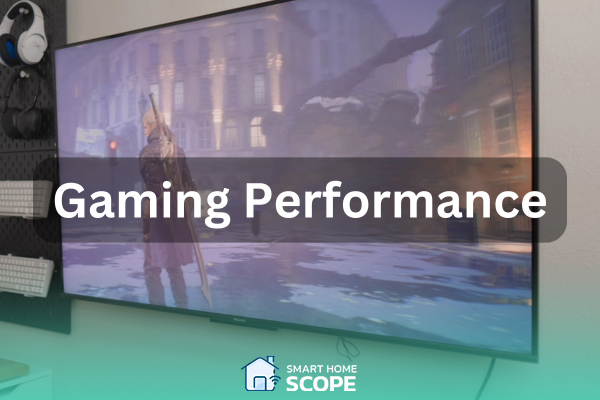
Gaming Performance Comparison
Vizio TVs Gaming Performance
It is obvious that Vizio has put a strong emphasis on gaming across its product lineup. Even in a budget series like the Vizio V-Series, you can see decent gaming features like low input lag and VRR (Variable Refresh Rate) support. VRR helps reduce stuttering and tearing of the display.
In midrange and premium Vizio TVs, there are more features to satisfy gamers. The Vizio M-Series Quantum, for example, offers a 120Hz refresh rate, low input lag, and support for VRR. These features ensure smooth gameplay with minimal screen tearing and lag.
Additionally, Vizio TVs support HDMI 2.1 in midrange to premium models, which means they are capable of handling 4K gaming at high frame rates, making them suitable for consoles like PS5 and Xbox Series- X.
Hisense TVs Gaming Performance
Hisense doesn’t fall short of Vizio when it comes to gaming performance. Budget models like the famous U6K, while having a 60Hz refresh rate similar to the Vizio V-Series, also include VRR and low input lag to reduce screen tearing.
In midrange to premium Hisense TVs like the U7K and U8K series, you’ll find additional features that enhance gaming, such as a 120Hz refresh rate, low input lag, VRR, and support for HDMI 2.1 for 4K gaming.
Gaming Experience: Verdict
Although both brands’ TVs are equipped with the most necessary features for a smooth gaming experience, as discussed in the picture quality section, Hisense gets a slight edge here since its TVs offer better contrast and brightness, making the gaming experience more immersive, especially in HDR. That said, the Vizio V-Series is still a good choice and very appealing for people on a tight budget who can’t afford the Hisense U6K.
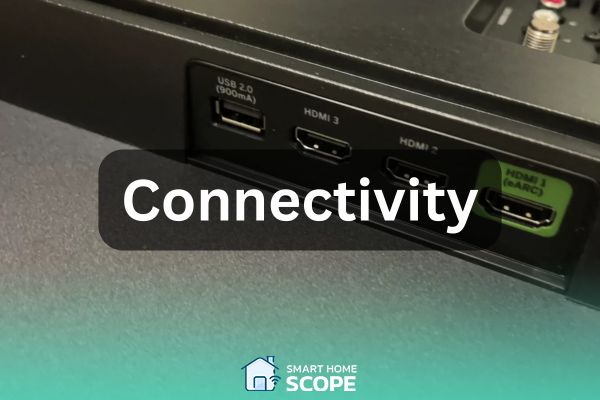
Connectivity Comparison
Connectivity is crucial, especially if you plan to connect many external devices to your TV. Both brands offer the main ports you’d expect from a TV, including RCA, optical, Ethernet, and AUX. However, on Hisense TVs like the U7K and U8K series, you’ll find two HDMI 2.1 ports, while on comparable Vizio series (M and P), there is only one. This is a negative point for Vizio TVs and bad news for people with many external devices.
Both brands offer HDMI eARC ports across all price ranges, which is important for connecting external audio devices to the TV, like soundbars.
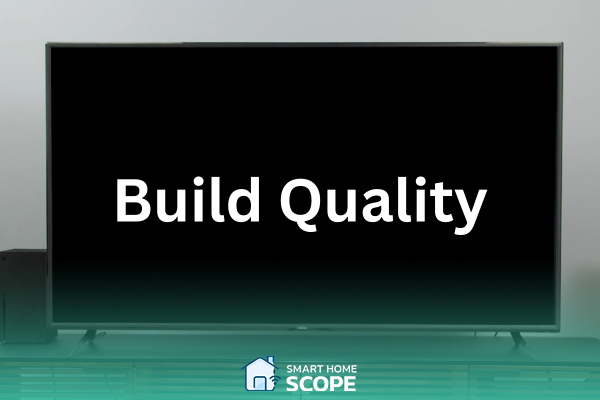
Vizio vs Hisense: Build Quality and Design
Vizio and Hisense are both promising when it comes to build quality, but with different philosophies.
Vizio TVs, especially those in the midrange to premium price range, feature a minimalistic design with slim bezels (the frame around the screen) and a combination of metal and plastic, giving them a modern and durable feel.
Hisense, on the other hand, gives its TVs a more industrial design, particularly in higher-end models like the U8K series. They generally focus on robustness and durability, using metal and high-quality plastic for their frames. Their main focus is on functionality rather than aesthetic appeal.
Sound Quality Comparison
In my opinion, TV speakers aren’t reliable sources for audio. They’re great for everyday TV watching, like the news or sports, but they don’t offer the immersion you expect when watching a movie or playing games.
Considering this, Vizio takes the lead here. Vizio offers its dedicated, Vizio-branded soundbars and subwoofers, which are high-quality devices perfect for enhancing your sound experience. The good thing about having both a Vizio TV and soundbar is that you don’t have to worry about compatibility issues, and the setup process is hassle-free.
Conclusion
In conclusion, I suggest opting for a TV from Hisense! As we’ve gone through the most important aspects for TVs and compared Vizio vs Hisense, you’ve seen that Hisense is the superior brand in terms of picture quality, gaming experience, and connectivity, making it the better choice. However, for those on a tight budget, the Vizio V-Series is still a solid option.
